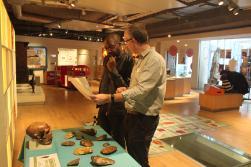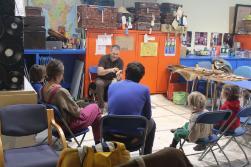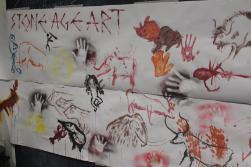Being Human in Ice Age Hackney
As part of last month's Being Human Festival, Claire Harris and Rob Davis, School of Geography, ran family workshops at Hackney Museum. Find out what they learnt-including the importance of a lie in!
Living in Ice Age Hackney was a contribution to the 2018 Being Human Festival of Humanities. We aimed to tell the story of Hackney’s ice age past through the objects held in the museum’s collection and interactive demonstrations. Hackney Museum describes itself as a “family friendly community museum” and this, together with its layout, complete with a workshop area, made it the perfect venue for this event.
Hackney was a key locality for pioneers of Palaeolithic archaeology during the urban expansion of the 1870s-1890s. As open ground gave way to housing stock, gravel and brickearth pits together with sewer trenches and basement excavations provided fertile ground for artefact-hunting. Our research for the Mapping Palaeolithic Britain project highlighted the significance of these historic collections and provides an interesting story for local residents who might not be aware of the archaeology beneath their feet! The museum’s popular and successful schools’ program focuses on the last 300 years, this event introduced local children to the earliest inhabitants of the area who lived 300,000 years ago.
Our one day, pop-up exhibit had three components. A table-top display of Palaeolithic artefacts and bones and teeth of ice age mammals from the museum’s collection provided a focus for discussion. Visitors were able to handle the objects and talk to QM researchers about their significance for understanding Hackney’s Ice Age past (photo 1).
The objects also set the scene for us to talk to visitors about how they were made, leading nicely into the second activity. An expert flint knapper, Karl Lee of Primitive Technology, demonstrated the basics of how to make a stone tool and talked the audience through the challenges that early humans faced when making these tools.
As knapping was unfamiliar to most of our visitors, adults and children alike were intrigued to watch Karl turn a lump of flint into a beautiful handaxe in a matter of minutes. Some children tried their hand at making a flint scraper under the watchful eye of Karl
Our final activity was an art area where children (and adults) were encouraged to think about the ice age animals that would have roamed Hackney and to then depict them using either clay or paints (photo 7).
We wanted to encourage families to drop in to our event so it was un-ticketed, with sufficient flexibility to deal with both larger and smaller visitor numbers. The three complementary activities worked well and engaged visitors in different ways and, being spatially distinct, we were able to manage the flow of visitors between them. The event also provided an opportunity to work with Hackney Museum and find out about their collections. We would like to thank the staff of Hackney Museum for enabling this event to take place and we hope to develop this collaboration further. We enjoyed the day enormously and, as organisers, the main take-aways were around maximising event publicity and effective messaging of the value of our research to a wider audience – and that people like a lie in on Saturdays!


